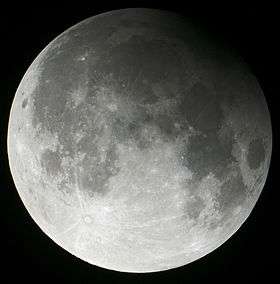January 1953 lunar eclipse
| Total Lunar Eclipse January 29, 1953 | |
|---|---|
| (No photo) | |
 The moon passes west to east (right to left) across the Earth's umbral shadow, shown in hourly intervals. | |
| Series | 123 (49 of 73) |
| Duration (hr:mn:sc) | |
| Totality | |
| Partial | |
| Penumbral | |
| Contacts | |
| P1 | UTC |
| U1 | |
| U2 | |
| Greatest | |
| U3 | |
| U4 | |
| P4 | |
A total lunar eclipse took place on January 29, 1953. The moon passed through the center of the Earth's shadow.[1]
Visibility
It could be completely seen from Europe and Africa, seen rising from North and South America, and setting over Asia.

Related lunar eclipses
Lunar year series
| Descending node | Ascending node | |||||
|---|---|---|---|---|---|---|
| Saros | Date Viewing |
Type Chart |
Saros | Date Viewing |
Type Chart | |
| 103 | 1951 Feb 21 |
Penumbral |
108 | 1951 Aug 17 |
Penumbral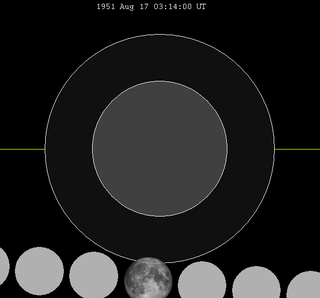 | |
| 113 | 1952 Feb 11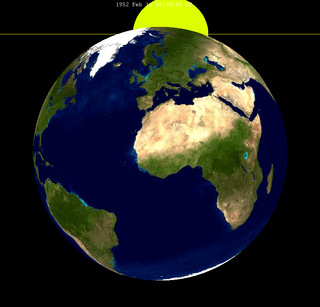 |
Partial |
118 | 1952 Aug 5 |
Partial | |
| 123 | 1953 Jan 29 |
Total |
128 | 1953 Jul 26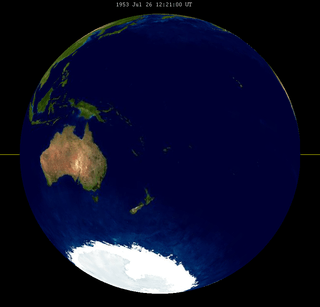 |
Total | |
| 133 | 1954 Jan 19 |
Total |
138 | 1954 Jul 16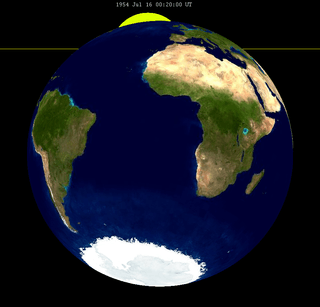 |
Partial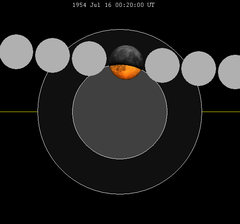 | |
| 143 | 1955 Jan 8 |
Penumbral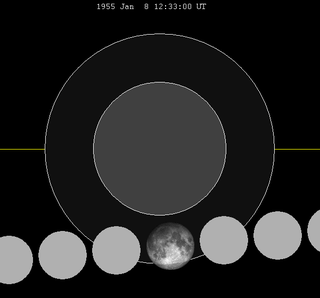 | ||||
| Last set | 1951 Mar 23 | Last set | 1951 Sep 15 | |||
| Next set | 1955 Nov 29 | Next set | 1955 Jun 5 | |||
Tritos series
The tritos series repeats 31 days short of 11 years at alternating nodes. Sequential events have incremental Saros cycle indices.
This series produces 23 total eclipses between June 22, 1880 and August 9, 2120.
| Ascending node | Descending node | |||||
|---|---|---|---|---|---|---|
| Saros | Date Viewing |
Type chart |
Saros | Date Viewing |
Type chart | |
| 119 | 1902 Apr 22 |
Partial |
120 | 1913 Mar 22 |
Partial | |
| 121 | 1924 Feb 20 |
Partial |
122 | 1935 Jan 19 |
Partial | |
| 124 | 1945 Dec 19 |
Partial |
125 | 1956 Nov 18 |
Total | |
| 126 | 1967 Oct 18 |
Total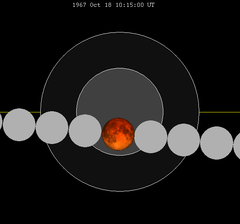 |
127 | 1978 Sep 16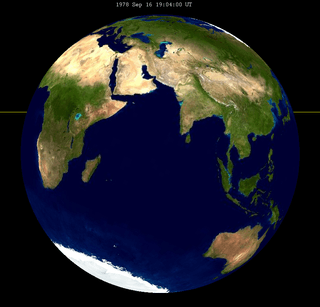 |
Total | |
| 128 | 1989 Aug 17 |
Total |
129 | 2000 Jul 16 |
Total | |
| 130 | 2011 Jun 15 |
Total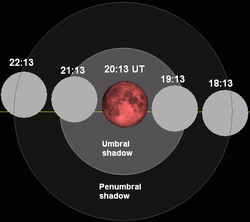 |
131 | 2022 May 16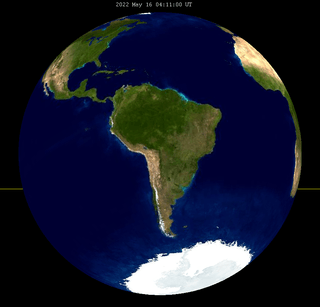 |
Total | |
| 132 | 2033 Apr 14 |
Total |
133 | 2044 Mar 13 |
Total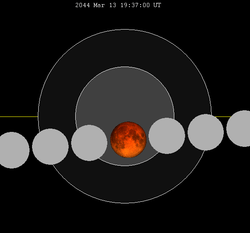 | |
| 134 | 2055 Feb 11 |
Total |
135 | 2066 Jan 11 |
Total | |
| 136 | 2076 Dec 10 |
Total |
137 | 2087 Nov 10 |
Total | |
| 138 | 2098 Oct 10 |
Total | ||||
See also
Notes
External links
- 1953 Jan 29 chart Eclipse Predictions by Fred Espenak, NASA/GSFC
This article is issued from Wikipedia - version of the 5/6/2016. The text is available under the Creative Commons Attribution/Share Alike but additional terms may apply for the media files.
